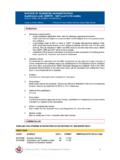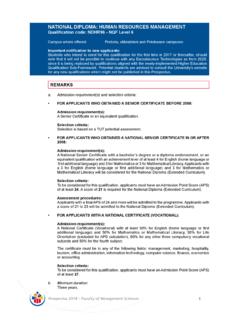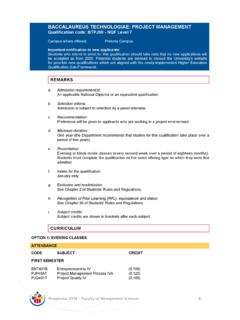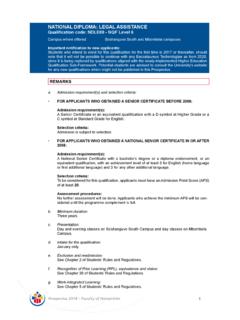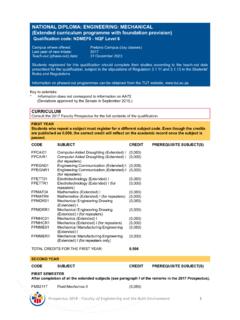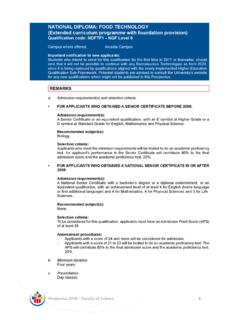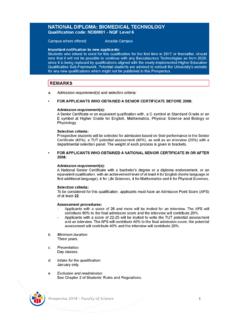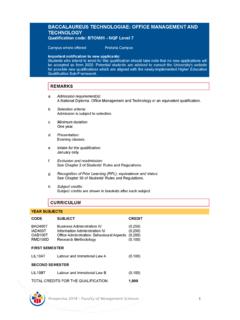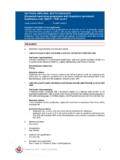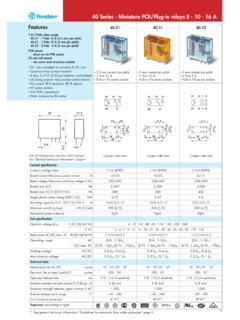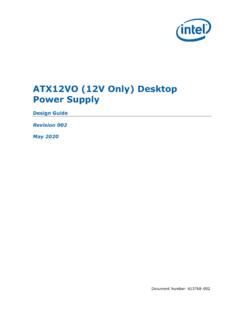Transcription of HIGHER CERTIFICATE IN ELECTRICAL ENGINEERING ... - tut.ac.za
1 1 Faculty of ENGINEERING and the Built EnvironmentHIGHER CERTIFICATE IN ELECTRICAL ENGINEERINGHCert ( ELECTRICAL ENGINEERING ) - NQF Level 5 (140 credits)Qualification code: HCEE18 SAQA ID: 97909, CHE NUMBER: H/H16/E033 CAN Campus where offered: Pretoria and eMalahleni campusesREMARKS a. Admission requirement(s) and selection criteria: APPLICANTS WITH A SENIOR CERTIFICATE OBTAINED BEFORE 2008: Admission requirement(s):A Senior CERTIFICATE or an equivalent qualification, with C symbols at Standard or D symbols at HIGHER Grade for English and Mathematics, and a D symbol at Standard Grade or an E symbol at HIGHER Grade for Physical criteria:To be considered for this qualification, applicants must have an Admission Point Score (APS)of at least subject(s):None. APPLICANTS WITH A NATIONAL SENIOR CERTIFICATE OBTAINED IN OR AFTER 2008:Admission requirement(s):A National Senior CERTIFICATE with a bachelor s degree, or a diploma, or a HIGHER CERTIFICATE endorsement or an equivalent qualification, with an achievement level of at least 4 for English (home language or first additional language) and Mathematics or Technical Mathematics, and at least a 3 for Physical Sciences or Technical Sciences.
2 Applicants who do not meet the requirements for Mathematics, Physical Sciences, or any of the two additional subjects may enroll for these subjects at any Technical and Vocational Education and Training (TVET) College (see National N CERTIFICATE requirements), and if these are successfully passed at a performance level of at least 50%, they may re-apply for admission to the criteria:To be considered for this qualification, applicants must have an Admission Point Score (APS) of at least 20 (excluding Life Orientation). Recommended subject(s): ELECTRICAL Technology. APPLICANTS WITH A NATIONAL CERTIFICATE (VOCATIONAL) AT NQF LEVEL 4:Admission requirement(s):A National CERTIFICATE (Vocational) at NQF Level 4, with a bachelor s degree or a diploma, or a HIGHER CERTIFICATE endorsement, issued by the Council for Quality Assurance in General and Further Education and Training (Umalusi), with at least 50% (APS of 4) for English and Mathematics, and 50% for Life Orientation (excluded for APS calculation) and 40% (APS of 3) for Science, and any other three compulsory vocational criteria:To be considered for this qualification, applicants must have an Admission Point Score (APS) of at least 20 (excluding Life Orientation).
3 2 Faculty of ENGINEERING and the Built EnvironmentRecommended subject(s):Digital Electronics, ELECTRICAL Principles and Practice, ELECTRICAL Principles and Construction, ELECTRICAL Workmanship and Electronic Control. APPLICANTS WITH A NATIONAL N CERTIFICATE /NATIONAL SENIOR CERTIFICATE AS PUBLISHED IN REPORT 191: N3 (NQF LEVEL 4):Admission requirement(s):A National Senior CERTIFICATE or a National N CERTIFICATE with languages as published inReport 191: N3 (NQF Level 4) issued by both the Department of HIGHER Education and Training(DHET) and the Council for Quality Assurance in General and Further Education and Training(Umalusi), with at least 50% for English, Mathematics N3, ENGINEERING Sciences N3 and anyother two additional criteria:To be considered for this qualification, applicants must have an Admission Point Score (APS) of at least 20 (excluding Life Orientation).
4 Recommended subject(s):None. APPLICANTS WITH A N4 CERTIFICATE IN A RELATED ENGINEERING FIELD AS PUB-LISHED IN REPORT 191: N4:Admission requirement(s):A N4 CERTIFICATE in a related ENGINEERING field as published in Report 191: N4 issued byboth the Department of HIGHER Education and Training (DHET) and the Council for Quality Assurance in General and Further Education and Training (Umalusi), with at least an average of 50% for the qualification, and successful completion of an English Language Proficiency Assessment (done by the University).b. Assessment procedure(s): No further assessment will be done (except for candidates with a N4 CERTIFICATE ). Applicants who achieve the minimum APS will be considered until the programme complement is full. All completed applications received within the published due dates will be ranked.
5 After consideration of the Departmental Student Enrolment Plan, only the top ranking applicants will be selected. Once a programme is full, a waiting list will be in place to provide an opportunity for applicants to fill places of those who did not register on time. Applicants will be informed of their status per official letter from the Office of the Registrar, alternatively, they can check their application status on the TUT website, c. Recognition of Prior Learning (RPL), equivalence and status:See Chapter 30 of Students Rules and Regulations. d. Intake for the qualification:January Presentation: Day classes. Classes and assessments may take place on Friday afternoons and/or Satur-days. f. Minimum duration:One Exclusion and readmission:See Chapter 2 of Students Rules and Regulations.
6 3 Faculty of ENGINEERING and the Built EnvironmentCURRICULUMATTENDANCECODE MODULE NQF-L CREDIT CML105X Computer Literacy (5) (10)COM105X Communication Skills (5) (8)EGL105C ENGINEERING Graphics (5) (14) EPH105C ENGINEERING Physics (5) (14)INL125C Information Literacy (block module) (5) (1)LFS125X Life Skills (block module) (5) (2) TMA105C Technical Mathematics (5) (21)FIRST SEMESTEREEN115C ELECTRICAL Technology (5) (14)WSP115C Workshop Practice (5) (14)SECOND SEMESTERDSY115C Digital Technology (5) (14)ETY115C Electronic Technology (5) (14) plus one of the following modules:ATE115C Autotronic Technology (not (5) (14) offered on eMalahleni Campus)ELA115C Electronic Assembly (5) (14)TOTAL CREDITS FOR THE QUALIFICATION: 140 MODULE INFORMATION (OVERVIEW OF SYLLABUS)The syllabus content is subject to change to accommodate industry changes.
7 Please note that a more detailed syllabus is available at the Department or in the study guide that is applicable to a particular module. At time of publication, the syllabus content was defined as follows:AAUTOTRONIC TECHNOLOGY (ATE115C) CONTINUOUS ASSESSMENT (Module custodian: Department of ELECTRICAL ENGINEERING )Basic ELECTRICAL Technology. Measurement principles. Electrochemical energy storage and generation. Electro-magnetic actuators and principles of sensors. alternating current Theory, generation, regulation, application. Digi-tal techniques and field programmable gate arrays. Electronic Communication networks (CAN bus) and wirelessnetworks (Android based). Project. (Total notional time: 140 hours)CCOMMUNICATION SKILLS (COM105X) 1 X 2-HOUR PAPER (Module custodian: Department of Industrial ENGINEERING )To identify and apply basic competencies related to communicating in a technical or ENGINEERING environment.
8 These competencies include presenting technical information to a variety of audiences, preparing technical reports, participating constructively in formal meetings and preparing a variety of business and technical documents. (Total notional time: 80 hours)4 Faculty of ENGINEERING and the Built EnvironmentCOMPUTER LITERACY (CML105X) CONTINUOUS ASSESSMENT (Module custodian: End User Computing Unit)This module provides foundational knowledge in computing fundamentals, essential digital skills in key applications based on MS Office Suite and network basics ( MS Outlook and Internet). Online exams are mapped with End-User Computing: SAQA 49077 (61591) Core Element as well as Internet and Computing Core Certification. (IC3). (Total notional time: 100 hours)DDIGITAL TECHNOLOGY (DSY115C) 1 X 3-HOUR PAPER(Module custodian: Department of ELECTRICAL ENGINEERING )Introductory digital concepts; Number systems (Decimal, Binary, Hexadecimal, Octal); Logic gates (AND, OR, NOT, NAND, NOR, XOR, XNOR), Boolean Algebra, Karnaugh Maps, Design Techniques and Code Converters; Combinational Logic: Adders, Comparators, Multiplexers, Demultiplexers, Encoders, Decoders, Code converters; Latches and Flip-Flops, 555 Timers; Asynchronous and Synchronous counters.
9 (Total notional time: 140 hours)EELECTRICAL TECHNOLOGY (EEN115C) 1 X 3-HOUR PAPER (Module custodian: Department of ELECTRICAL ENGINEERING )Basic ELECTRICAL Technology (DC). ELECTRICAL Circuits (DC). Electrostatics (DC). Magnetism and electromag-netism. alternating current Theory. alternating current Circuits. ELECTRICAL System Networks. (Total notional time: 140 hours)ELECTRONIC ASSEMBLY (ELA115C) CONTINUOUS ASSESSMENT(Module custodian: Department of ELECTRICAL ENGINEERING )Introduction to manufacturing and production processes; Tools, components and PCB selection and preparation; Through-hole assembly techniques; Surface mount assembly techniques; Cleaning, inspection, testing, and packaging of electronic assemblies. (Total notional time: 140 hours)ELECTRONIC TECHNOLOGY (ETY115C) 1 X 3 HOUR PAPER (Module custodian: Department of ELECTRICAL ENGINEERING )Passive and active components, Diodes and special diodes; Power supply construction; Bipolar Junction Transistors; Field Effect Transistors; Introduction to signal analysis.
10 (Total notional time: 140 hours) ENGINEERING GRAPHICS (EGL105C) CONTINUOUS ASSESSMENT(Module custodian: Department of Mechanical and Mechatronics ENGINEERING )Introduction to graphics communication. Dimensioning and tolerance practices. Geometrical construction. Pictorial projections. Interpenetration and development. Machine drawings. Civil drawings including ELECTRICAL diagrams. (Total notional time: 140 hours) ENGINEERING PHYSICS (EPH105C) 1 X 3-HOUR PAPER (Module custodian: Department of Physics)Basic mathematics and vectors. Measurements. Kinematics in 1 dimension. Forces and Newton s laws of motion. Work energy and power. Elasticity. Static and dynamic fluids. Temperature and heat. Wave properites. Reflection of light and mirrors; refraction of light and lenses and optical instruments. (Total notional time: 140 hours)IINFORMATION LITERACY (INL125C) CONTINUOUS ASSESSMENT(Module custodian: Directorate of Library and Information Services)Introduction of information literacy.
